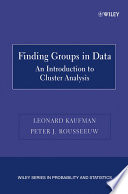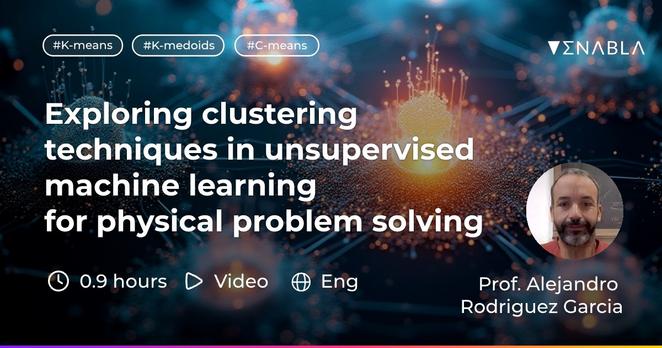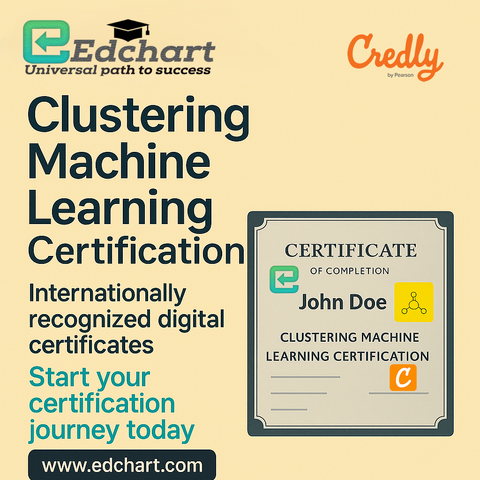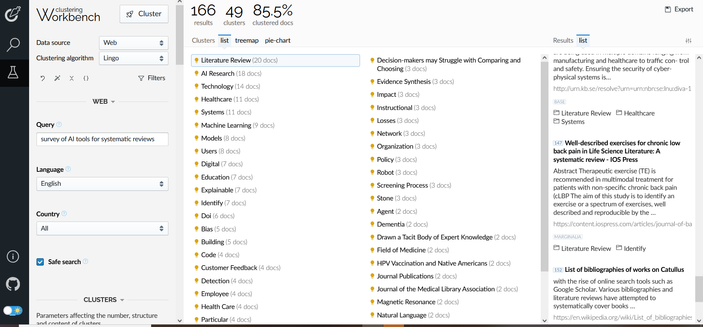(PDF) Uncovering spatial and v...
(PDF) Uncovering spatial and v...
New article on my website: A slight speed improvement on the DIANA algorithm
Don't pass by the new insightful lecture from Dr. Alejandro Rodriguez Garcia, Abdus Salam International Centre for Theoretical Physics (ICTP)!
In this one, Alex provides a comprehensive overview of various clustering methods, including flat, fuzzy, and hierarchical approaches. His lecture not only discusses the mathematical foundations of techniques like k-means and k-medoids but also highlights their practical applications across fields such as image recognition and data classification.
This lecture is an excellent opportunity to deepen your understanding of unsupervised learning and engage critically with advanced clustering methods.
Join Enabla to watch the lecture and interact with Dr. Rodriguez Garcia for free! Ask questions and spark discussions with both him and the rest of the Enabla community: https://enabla.com/pub/1109/about
#UnsupervisedLearning #MachineLearning #DataScience #Clustering #OpenAccess
Clustering Machine Learning Certification
🌐 Take the exam online: https://www.edchart.com/certificate/clustering-machine-learning-certification-exam-free-test
📛 Get your verified digital credential: https://www.credly.com/org/edchart-technologies/badge/edchart-certified-clustering-machine-learning-subje
EdChart now offers the Clustering Machine Learning Certification, recognized globally and trusted by professionals. Take the online exam from anywhere in the world, and pay only if you pass.
#MachineLearning #Clustering #DataScience #MLCertification #OnlineCertification #AIProfessionals #SoftwareDevelopers #GlobalCredential
I'm convinced (implementing and testing it actually confirm it too) that choosing any cluster of size >1 leads to the same result (cause any split occurs inside one cluster and is not influenced by the other clusters) and is less computationally expensive (cause you don't need to search which is the largest cluster).
Cf p.256 of "Finding Groups in Data: An Introduction to Cluster Analysis" by Leonard Kaufman, Peter J. Rousseeuw
https://books.google.co.jp/books?id=YeFQHiikNo0C&pg=PA253&redir_esc=y#v=onepage&q&f=false
#programming #algorithm #clustering

Finding Groups in Data
The Wiley-Interscience Paperback Series consists of selected books that have been made more accessible to consumers in an effort to increase global appeal and general circulation. With these new unabridged softcover volumes, Wiley hopes to extend the lives of these works by making them available to future generations of statisticians, mathematicians, and scientists. "Cluster analysis is the increasingly important and practical subject of finding groupings in data. The authors set out to write a book for the user who does not necessarily have an extensive background in mathematics. They succeed very well."—Mathematical Reviews "Finding Groups in Data [is] a clear, readable, and interesting presentation of a small number of clustering methods. In addition, the book introduced some interesting innovations of applied value to clustering literature."—Journal of Classification "This is a very good, easy-to-read, and practical book. It has many nice features and is highly recommended for students and practitioners in various fields of study."—Technometrics An introduction to the practical application of cluster analysis, this text presents a selection of methods that together can deal with most applications. These methods are chosen for their robustness, consistency, and general applicability. This book discusses various types of data, including interval-scaled and binary variables as well as similarity data, and explains how these can be transformed prior to clustering.
Ein lang ersehnter Wunsch von mir: Eigene #Clustering Methoden in #OpenRefine benutzen.
Verfügbar seit Version 3.9.0 und funktioniert seit 3.9.3 auch mit #Jython und #Clojure.
Hier eine Anleitung zur Benutzung im #FDMLab Blog.
https://fdmlab.landesarchiv-bw.de/workshop/openrefine-fortgeschrittene/19-erweitertes-clustering/
Clustering Workbench of the Carrot2 search engine is working now. It can
cluster search results by 3 algorithms:
Lingo, STC, or k=means. STC is Suffix Tree Clustering method, a fast, phrase-based clustering method that groups documents based on common, frequent phrases. The screenshot shows search results using Lingo clustering for query:
"survey of AI tools for systematic reviews."
https://search.carrot2.org/#/workbench
#research #academia #Carrot2
#systematicReview
#clustering #Lingo #STC #k-means
'Curvature-based Clustering on Graphs', by Yu Tian, Zachary Lubberts, Melanie Weber.
http://jmlr.org/papers/v26/24-0781.html
#clustering #communities #clusters
#30DayChartChallenge Día 14: Kinship! 🌿 Hoy toca visualizar "parentescos" animales, pero basados en ¡similitud de rasgos! #RelationshipsWeek #Animals
Este dendrograma horizontal es el resultado de un clustering jerárquico (hclust Ward.D2) sobre ~170 especies, usando su Masa Corporal y Longevidad Máxima (log-transformadas y escaladas). ¡Muestra quién se agrupa con quién según su estrategia de vida!
Las ramas unen las especies más similares. La longitud horizontal hasta la unión indica cuán diferentes son. Se ven grandes grupos que separan, por ejemplo, animales muy grandes/longevos de otros más pequeños/rápidos. Es una forma de ver la estructura oculta en los datos de rasgos.
(Solo se muestra 1/3 de las etiquetas para no saturar!)
🛠 #rstats #ggplot2 #ggdendro #stats | Datos: Kaggle (S. Banerjee)
📂 Código/Viz: https://t.ly/Y_fwt
#Day14 #Kinship #dataviz #DataVisualization #Ecology #LifeHistory #AnimalTraits #Clustering #Dendrogram #ggplot2 #Kaggle
On April 29th, at 2 PM ET, Lari Luoma, one of our Maestro experts from Check Point Professional Services, will provide a technical overview of Maestro along with some best practices. Topics include:
✔ What works, what doesn't based on 10 years of experience with Scalable Platforms
✔ From Security Gateways to cloud level hyper scalable clustering
✔ Working effectively with global command line
✔ Best practice configurations
Looking forward to seeing you there!
RSVP: https://checkpoint.zoom.us/webinar/register/6016273862243/WN_Ci-HjdKyR_WrOE3j0yZznA#/registration

Welcome! You are invited to join a webinar: Maestro Masters Americas: Introduction to Quantum Maestro Hyperscale Platform. After registering, you will receive a confirmation email about joining the webinar.
Lari Luoma, one of our Maestro experts from Check Point Professional Services, will provide a technical overview of Maestro along with some best practices. Topics include: What works, what doesn't based on 10 years of experience with Scalable Platforms From Security Gateways to cloud level hyper scalable clustering Working effectively with global command line Best practice configurations





